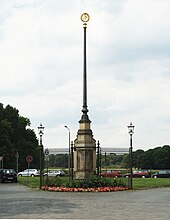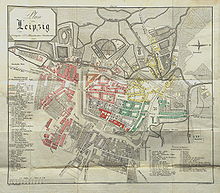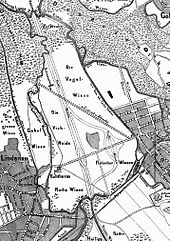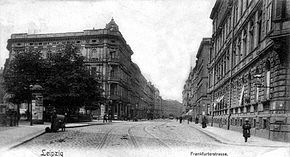Waldstrasse district
The Waldstrasse district is a residential area of the city of Leipzig northwest of the city center. It is considered to be one of the largest, closed, Wilhelminian-style districts in Europe and enjoys special protection as an architectural monument.
location
The Waldstraßenviertel extends to the streets around Waldstraße in Leipzig and essentially corresponds to the built-up part of the district Leipzig-Zentrum-Nordwest, which is through Friedrich-Ebert-Straße in the west, Elstermühlgraben and Emil-Fuchs-Straße in the northeast Pfaffendorfer Straße in the east and Ranstädter Steinweg and Jahnallee in the south. In part, the Käthe-Kollwitz-Straße is seen as the southern border, after which the Naundörfchen , the former Ranstädter suburb and the area around the northern Gottschedstraße also belong to the quarter. The name Waldstraßenviertel is not an official name for the district.
To the northeast of the Waldstrasse district is the Rosental as a public green area, to the west is the Sportforum with the central stadium and to the south is the inner west suburb .
From Jahnallee, Waldstrasse begins at Waldplatz as the central axis of the district in a north-south direction and divides it into the western and eastern Waldstrasse district. The northern area of the eastern Waldstrasse district is designed as an open villa development, while in the other parts a closed development along the streets predominates.
The Waldstrasse crosses Gustav-Adolf-Strasse, Hinrichsenstrasse (previously: Auenstrasse), Fregestrasse, Feuerbachstrasse (earlier: Sedanstrasse), Wettiner Strasse and Christianstrasse, starting from the south; In the western Waldstrasse district, the streets Am Mückenschlösschen and Goyastrasse follow.
Friedrich-Ebert-Straße (formerly: An der alten Elster) and Max-Planck-Straße (formerly: Elsässer Straße) run parallel to Waldstraße in the west and Liviastraße, Tschaikowskistraße (formerly: König-Johann-Straße), Funkenburgstraße, Leibnizstraße and Färberstrasse in the eastern Waldstrasse district. The Frege, Livia and Christianstraße allude to the Frege family from Leipzig .
East of the Elstermühlgraben, Gustav-Adolfstrasse becomes Humboldtstrasse and is crossed there by Jacobstrasse, Rosentalgasse and Lortzingstrasse. In the area of Jacobstrasse there was a Jacobskapelle, built long before the city was founded in the 11th century, as a medieval pilgrimage chapel on the pilgrimage route to Santiago de Compostela . For a long time, Rosentalgasse was the only access point from Leipzig to the Rosental and ran between Elstermühlgraben and Pleißemühlgraben. At its northern end is the entrance portal for the electoral park and palace complex in the Rosental, which was planned in the 18th century. Lortzingstrasse is reminiscent of the Leipzig bandmaster and composer Albert Lortzing , who temporarily lived in a garden house in the Great Funkenburg near Funkenburgstrasse.
history
Originally there was forest and meadow land on the site of the Waldstrasse district.
Slavic settlements probably arose very early in the area of the Elster and Pleiße . The Via Regia in the current course of Ranstädter Steinweg and Jahnallee was an old trade route that was protected by royal privileges. Iroschottische missionaries used the Via Regia as early as the 7th century and founded the Jakobskapelle, the first chapel in what was later to be the city.
In the period from the 10th to the 12th century, numerous river regulation measures took place, for example the Elstermühlgraben was built and the Parthe moved north. This made further settlement of the area possible.
The Via Regia was lined by two rows of houses on Ranstädter Steinweg as early as the Middle Ages, the Mühlgrabensiedlung emerged to the north and the Jacobsviertel or Jacobsparochie to the south, next to the Jacob's Chapel . The Naundörfchen was located south of the Jacobsviertel, it was first mentioned in 1295.
From these settlements, the Ranstädter Vorstadt or Rannische Vorstadt emerged in the 12th century , which was closed off at the height of the current Leibnizstrasse by the Outer Rannische Tor . In the Rannische Vorstadt mainly butchers, tanners, dyers and fishermen lived because of the two mill ditches.
The Jacobsmühle (later Angermühle ) stood near the Jacob's Chapel . To the north of it, the Georgenhospital between Elstermühlgraben and Pleiße on the edge of the Rosental was built in 1212 at the behest of the Margrave of Saxony Dietrich von Meißen .
Outside the Outer Rannischer Tor , north of the Via Regia, stood the Leipzig council brickwork. In the area of today's Funkenburgstrasse, a large Vorwerk , the Great Funkenburg , with a large garden, two lakes and several outbuildings was built around the year 1600 ; it served, among other things, as a restaurant and was a popular excursion destination in Leipzig.
Around 1830 the population of the city increased again by leaps and bounds, so that further development of the Waldstrasse district became necessary. However, the annual spring floods made this almost impossible and only after renewed regulatory measures could the construction begin.
From around 1830 the area of Lortzingstrasse / Rosentalgasse emerged from the buildings that still exist today. From around 1860 the area of Leibnizstraße followed, the layout of Waldplatz and the southern part of Waldstraße with its side streets up to Fregestraße - see adjacent map from 1867.
After the Great Funkenburg was demolished in 1897, the remaining area in the area of Funkenburg- and Tschaikowskistraße was included in the rectangular street pattern and the quarter was extended to the north to Christianstraße. The northern part, starting from Fregestraße, was built in open perimeter block development, often in the now modern design language of Art Nouveau . Well-known architects at the turn of the century such as Paul Möbius , Emil Franz Hänsel and Raymund Brachmann created striking residential buildings. At the northern end of the quarter, the forest road bridge over the Elstermühlgraben and in 1892/93 a garden restaurant and café was built, which is called Mückenschlösschen because of the area that was once rich in mosquitoes .
After the social equality of Jews in Saxony, the proportion of the Jewish population increased. This was particularly evident in the trading city of Leipzig, where the majority of the traders were Jews from Eastern Europe. Many of these settled in what is now the Waldstrasse district, where almost 20% of the population was of Jewish origin. Various Jewish social institutions emerged, such as the Eitingon Hospital or the Ariowitsch Foundation as an old people's home. The Jews of the Waldstrasse district were mainly employed in the tobacco industry. Up to 1933 around 2500 Jewish people lived in the Waldstrasse district.
The area between Christianstrasse and Goyastrasse was the last construction phase to be built from around 1925 to the 1960s. In addition to residential buildings, there is also the former Jewish ( Eitingon ) hospital in the street of the same name.
During the period of industrial housing construction from the 1970s onwards, the building fabric, which was badly damaged in some cases, was neglected, so that the houses continued to deteriorate. After reunification, the Wilhelminian style houses were gradually renovated.
In the area north of Goyastraße, individual residential buildings were built after 1990.
The city received a gold medal in the federal competition from the Federal Ministry for Spatial Planning, Building and Urban Development in 1994 for its strategy to preserve the Waldstrasse district . On the other hand, several well-preserved and listed buildings were demolished after 2000, for example the late classicistic little Funkenburg and the residential and commercial building Friedrich-Ebert-Straße 81 a / b , primarily for reasons of traffic planning, which led to massive public protests led.
economy
Up until the middle of the 20th century, there were a variety of craft businesses in the Waldstrasse district, the commercial operations of which took place mainly in the courtyards of the street district. There was also a piano factory on Sedanstrasse, a trimmings manufacturer and two factories for essential oils . The share of handicrafts gradually decreased after the Second World War. Automotive and mechanical engineering production facilities were built north of Goyastrasse. Today there are many retail stores and other businesses along Waldstrasse, Jahnallee and some other streets. However, this does not call into question the fundamental character of the Waldstrasse district as a residential area.
Public facilities
The Lessing elementary school and the sports high school as well as the Leipzig Natural History Museum are located in this quarter in the building of a former high school. The building of the former Israelite Higher School in Gustav-Adolf-Straße has housed the German Central Library for the Blind since 1954 .
Personalities
Many famous people lived in the Waldstrasse district, including many musicians. Examples are: Albin Ackermann-Teubner , Samuel Josef Agnon , August Bebel , Max Beckmann , Georg Bötticher , Hans Driesch , Bernard Katz , Paul Alfred Kleinert , Hans Mayer , Paul Julius Möbius , Joachim Ringelnatz , Auguste Schmidt , Georg Trexler .
In 1827/1828 the composer Heinrich Marschner lived in the Goldene Lute (Ranstädter Steinweg 8) and completed his opera The Vampyr here .
Albert Lortzing had several apartments in the Waldstrasse district: 1833–1838 in Naundörfchen (No. 1008), where he composed his opera Zar und Zimmermann , from 1838 on Frankfurter Strasse next to the great Funkenburg and from 1844 to 1846 in a garden house belonging to the greats Funkenburg.
Gustav Mahler lived in the house Gustav-Adolf-Straße 12 in 1887/88 and wrote his 1st symphony there, among other things.
literature
- Horst Riedel: City Lexicon Leipzig . Pro Leipzig, 2005, ISBN 978-3-936508-03-1 (including key words Waldstraßenviertel , Große Funkenburg , maps on the cover pages).
Web links
- Search hit for the keyword Waldstraßenviertel on the website of the city of Leipzig * Official website of the Bürgererverein Waldstraßenviertel eV
Individual evidence
- ^ André Loh-Kliesch: Leipzig Lexicon
- ↑ location. In: waldstrassenviertel.de. Bürgererverein Waldstraßenviertel eV, accessed on May 22, 2019 .
- ^ Horst Riedel: Stadtlexikon Leipzig, Pro Leipzig, 2005, p. 268, p. 486 Jacobsviertel , Rannische Vorstadt
- ↑ See Riedel 2005, p. 268 Jacobsviertel
- ↑ Cf. Riedel 2005, p. 200 Große Funkenburg
- ↑ See Riedel 2005, p. 414 Mückenschlösschen
- ↑ Albert Lortzing's house. In: Leipzig sheet music. Retrieved April 6, 2020 .
- ↑ Memorial plaque on the composer's house
Coordinates: 51 ° 20 ′ 45.7 ″ N , 12 ° 21 ′ 24.9 ″ E









